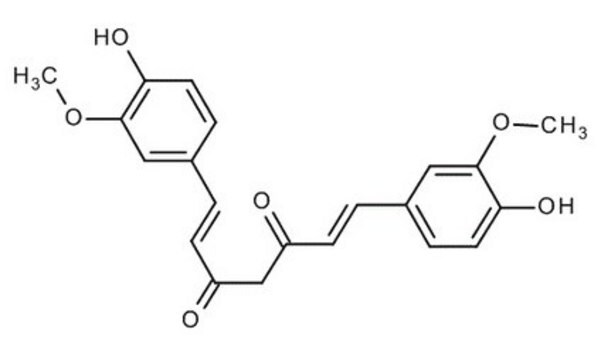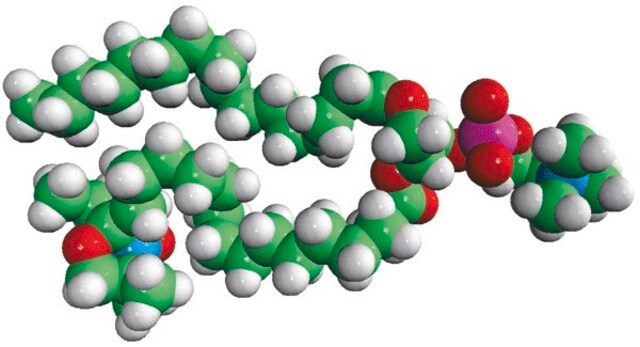810601P
Avanti
16:0-5 Doxyl PC
Avanti Research™ - A Croda Brand 810601P, powder
Synonym(s):
1-palmitoyl-2-stearoyl-(5-doxyl)-sn-glycero-3-phosphocholine
Sign Into View Organizational & Contract Pricing
All Photos(1)
About This Item
Empirical Formula (Hill Notation):
C46H90N2O10P
CAS Number:
Molecular Weight:
862.19
UNSPSC Code:
41141825
NACRES:
NA.25
Recommended Products
Assay
>99% (TLC)
form
powder
packaging
pkg of 1 × 1 mg (810601P-1mg)
manufacturer/tradename
Avanti Research™ - A Croda Brand 810601P
lipid type
ESR probes
phospholipids
shipped in
dry ice
storage temp.
−20°C
General description
Avanti′s nitroxide spin product listing is a group of compounds designed to act as membrane probes. A variety of positions down the hydrophobic chain are labeled with the nitroxide functional groups to allow probing the membrane at various depths. These compounds have been synthesized from 1-palmitoyl-2-hydroxy-sn-glycerol-3-phosphocholine with the product being purified by column chromatography. Various n-doxyl phosphocholines have been recently used as biophysical tools to elucidate membrane trafficking with phosphatidylinositol transfer proteins and as fluorescent quenchers in lipid bilayer structural studies.
Phosphatidylcholine (PC), a strong bilayer-forming lipid is the most common phospholipid in mammalian membranes. The excretory and secretory products of helminths has a small hapten-like portion called phosphorylcholine (PC). The 5th carbon of the sn-2 stearic acid chain of 1-palmitoyl-2-stearoyl-(5-doxyl)-sn-glycero-3-phosphocholine analog has a Doxyl PC, a spin probe attached to it covalently.
Application
16:0-5 Doxyl PC may be used:
- as a component in virus-like large unilamellar vesicles (VL LUVs) to quench 4-chloro-7-nitrobenz-2-oxa-1,3-diazole (NBD) fluorescence emission
- in the preparation of multi-lamellar vesicles (MLVs) as a site-specific quencher to perform fluorescence quenching studies
- in the preparation of spin-labelled multi-lamellar vesicles (MLVs)
Biochem/physiol Actions
Phosphatidylcholine (PC) lowers the levels of cholesterol and triglycerides.
Packaging
5 mL Clear Glass Sealed Ampule (810601P-1mg)
Preparation Note
Product use: To prevent aggregation, prepare water-based solutions of 2 mM stock solutions of n-DOXYL PCs and store in plastic. Dilute stock solutions to 0.03- 0.1 mM solutions for EPR studies. For liposome preparations in fluorescent quenching measurements, dissolve the doxyl lipid in 150 μl absolute ethanol for a concentration of 40.3 mM , Additional supplemental information.
Legal Information
Avanti Research is a trademark of Avanti Polar Lipids, LLC
also commonly purchased with this product
Storage Class Code
11 - Combustible Solids
Choose from one of the most recent versions:
Certificates of Analysis (COA)
Lot/Batch Number
Sorry, we don't have COAs for this product available online at this time.
If you need assistance, please contact Customer Support.
Already Own This Product?
Find documentation for the products that you have recently purchased in the Document Library.
Edurne Rujas et al.
The Journal of biological chemistry, 292(13), 5571-5583 (2017-02-19)
The 4E10 antibody displays an extreme breadth of HIV-1 neutralization and therefore constitutes a suitable model system for structure-guided vaccine design and immunotherapeutics against AIDS. In this regard, the relevance of autoreactivity with membrane lipids for the biological function of
Alexander Vogel et al.
Biophysical journal, 85(3), 1691-1701 (2003-08-29)
The distribution of the lipid-attached doxyl electron paramagnetic resonance (EPR) spin label in 1-palmitoyl-2-oleoyl-sn-glycero-3-phosphocholine membranes has been studied by (1)H and (13)C magic angle spinning nuclear magnetic resonance relaxation measurements. The doxyl spin label was covalently attached to the 5th
Diego E Sastre et al.
The Journal of biological chemistry, 295(7), 2136-2147 (2019-12-05)
PlsX plays a central role in the coordination of fatty acid and phospholipid biosynthesis in Gram-positive bacteria. PlsX is a peripheral membrane acyltransferase that catalyzes the conversion of acyl-ACP to acyl-phosphate, which is in turn utilized by the polytopic membrane
Phosphatidylserine dynamics in cellular membranes.
Kay, J.G
Molecular Biology of the Cell, 23, 2198-2212 (2012)
Insight into antibody combining sites using nuclear magnetic resonance and spin label haptens
McConnell HM
Advances in Protein Chemistry, 49, 135-148 (1996)
Our team of scientists has experience in all areas of research including Life Science, Material Science, Chemical Synthesis, Chromatography, Analytical and many others.
Contact Technical Service







